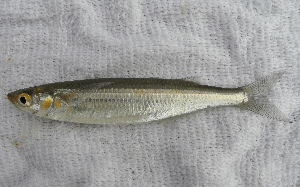Topsmelt silverside facts for kids
Quick facts for kids Topsmelt silverside |
|
|---|---|
 |
|
| Conservation status | |
| Scientific classification | |
| Synonyms | |
|
The topsmelt silverside (Atherinops affinis) is a small, thin fish. People also call it the topsmelt. It lives in the eastern Pacific Ocean. It is a type of silverside fish.
Contents
What Does the Topsmelt Silverside Look Like?
This fish is small and slim. It has a flat back. It can grow up to about 37 centimetres (15 in) long. Its back is bright green. Its sides are silver or pale, and its belly is silvery. This makes a nice contrast.
The topsmelt silverside has a pointed head. Its eyes are small. It has a rounded snout and a mouth that points slightly upwards. Its jaws can extend, and they have tiny, forked teeth. The gills of this fish are a golden-yellow color.
It does not have a lateral line, which is a sensory organ many fish have. However, it has 63 to 65 scales where the lateral line would normally be. It has two separate dorsal fins on its back. The first dorsal fin has 5 to 9 spines. The second dorsal fin has one spine and 8 to 14 soft rays. The anal fin also has one spine and 19 to 25 rays. Its pectoral fins have 13 rays each.
Young topsmelt silversides are almost clear, or translucent. They have three rows of dark scales on their back. These scales become more spread out near their tail.
Where Do Topsmelt Silversides Live?
The topsmelt silverside lives in the eastern Pacific Ocean. You can find it along the western coast of North America. Its range goes from Vancouver Island in British Columbia, Canada, all the way south to Baja California and the Gulf of California in Mexico.
Home and Habits
Topsmelt silversides are fish that swim in schools. This means they swim together in large groups. They live in many different places throughout the year. They are very common in estuaries, which are areas where rivers meet the sea. You can also find them along ocean shorelines, in kelp forests, near sandy beaches, and sometimes further out in the ocean.
These fish often gather around human-made structures. This includes things like pier pilings. They usually swim just below the water's surface. Most often, they are found in the top 9 metres (30 ft) of water.
During spring and summer, many topsmelt silversides move into estuaries. In autumn and winter, they move to more open coastlines. Here, they can be found in bays, rocky areas, and kelp beds. They can even live in very salty water, like salt evaporation ponds. They can handle salt levels as high as 80 ppt, which is much saltier than regular seawater.
Reproduction
Topsmelt silversides lay their eggs, or spawn, during the warmer months. This happens from March to October. They prefer to spawn in water that is about 30 ppt salty. The water temperature they like for spawning is between 13–27 °C (55–81 °F). They usually lay their eggs at night on plants that are underwater.
After the eggs hatch in deeper water, the young fish, called larvae, may move up into the estuary. The youngest fish, less than a year old, are most often found in freshwater areas. As they get older, they move downstream towards saltier estuary environments.
What Do They Eat?
Young topsmelt silversides eat tiny animals called zooplankton. Adult topsmelt silversides usually look for food near the bottom. Their diet can include algae, which are simple water plants. They also eat insect larvae, like chironomid larvae, and small crustaceans called amphipods. Sometimes, sand and gravel are found in their stomachs. This shows that they feed on the bottom.
Topsmelt silversides are often seen jumping out of the water. They do this to escape from bigger fish that hunt them. These predators can include fish like mackerel or jacks.


